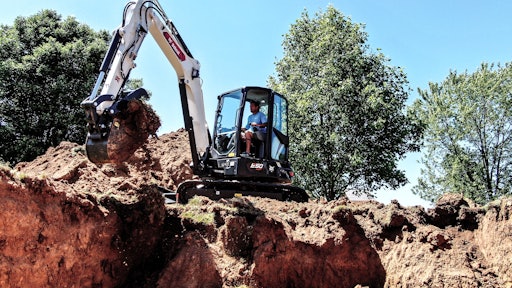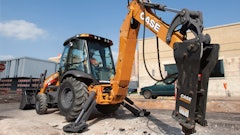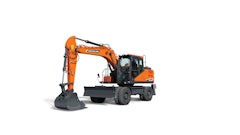
A compact excavator can be your most important jobsite VIP, and an investment that provides great returns job after job. However, staying committed to a regular maintenance plan is key to reaping all the benefits of owning these versatile machines. Here are 10 tips for getting more hours out of the day and more working days out of the season with your compact excavator.
1. Read the Compact Excavator’s Manual
An operator’s first task is to review the compact excavator’s Operation & Maintenance manual to become familiar with the machine’s safety features, instrumentation, controls, service schedules and maintenance points. The operator’s manual is delivered with the machine and contains manufacturer service and maintenance recommendations. If you misplace your manual, you can buy replacements from your local dealer or at the online Bobcat store.
Most compact excavators come with an operator’s handbook, conveniently stored in an easily accessible area in the excavator cab. It’s a good resource for operators to review prior to using a compact excavator, regardless of their experience level.
2. Top Machine Fluids off Daily
An effective maintenance regimen starts with daily checks of fluids, including coolant, hydraulic fluid and engine oil. If levels are low, refill with the manufacturer’s recommended type of fluid, paying particular attention to classifications, as well as viscosities for the operating environment. When checking levels, avoid contaminants by keeping areas dirt free and using clean rags.
Emission-compliant diesel engine excavators have unique lubrication requirements. Manufacturers match oils to their advanced engines to ensure proper operation of exhaust after-treatment systems.
It’s also important to regularly lubricate a compact excavator’s boom and arm cylinders at recommended intervals, taking into consideration the application and temperatures where the machine will be working. To increase excavator uptime, manufacturers recommend quality lithium-based multipurpose grease to lubricate all key pivot points, including cylinders, booms, blades, buckets, arms and slew-bearing components. Download a copy of your compact excavator’s service schedules for easy reference.
3. Maintain Equipment Filters
A compact excavator has multiple filters – fuel, engine, air and hydraulic – and each may have different service intervals. When dirty or completely clogged, a filter can significantly reduce excavator uptime and reduce component life Most compact excavators have air filters with restriction indicators that alert operators to maintenance needs. To avoid system contamination, don’t remove the filter until it’s required.
4. Use Clean, Quality Fuel
Most manufacturers specify the use of clean, high-quality No. 2 or No. 1 grade diesel fuel. Compact excavator operators working in colder climates may prefer specially formulated blends designed to prevent gelling. At a minimum, compact excavators need ultra-low sulfur diesel fuel to reduce exhaust emission levels.
5. Inspect and Maintain Tracks
The most obvious wear item on a compact excavator undercarriage is the rubber tracks, which most compact excavators are manufactured with. Jobsite conditions and operator behavior affect track life expectancy. Examine tracks daily to look for cuts, tears and exposed steel embeds. Punctures and tears can allow moisture or contamination to enter the tracks, leading to rust and a shortened track life.
One of the most important undercarriage items to monitor is track tension. A loose track may de-track, impacting its life and the machine’s uptime. Reference your Operation & Maintenance manual for ideal track tension ranges and the correct way to position the compact excavator to make adjustments.
While a daily inspection isn’t required, regularly monitoring other undercarriage components like idlers, rollers and sprockets can help identify potential maintenance needs. Accelerated wear on the sprocket is not common, but you should still periodically examine the teeth. A good sprocket tooth has a rounded end, while a worn tooth is more pointed. Always check the sprocket condition when installing a new set of tracks.
Finally, one of the best ways to maintain tracks is to make sure that operators drive carefully and thoughtfully on the jobsite. Keeping best practices in mind for curbs, object avoidance, inclines/declines and avoiding chemicals and debris are key for preventing undue damage. Minimizing the excavator’s time on abrasive materials, such as concrete or asphalt, is also important. When the excavator is not in use, storage in a cool, dry environment also protects the machine.
6. Inspect the Excavator’s Cooling System Daily
An effective cooling system relies on adequate airflow and coolant levels. When airflow or coolant is low, your excavator can lose power and the engine can overheat, and cause damage. Proper cooling system maintenance includes checking for proper airflow and hose leaks. Clean the excavator’s radiator, oil cooler and condenser by applying low pressure air or water but be careful not to damage the radiator’s fins.
7. Maintain the Battery and Charging System
Battery cables should be tight and clean. Inspect for corrosion on the cable ends and the battery terminals. Fuses protect the electrical system in case of an overload. Always replace failed fuses with a fuse of the same amperage rating.
8. Keep Ground-Engaging Tools in Top Shape
Check attachment components, such as cutting edges, teeth and hoses, to determine if wear is developing or damage occurred in tough, rigorous applications. Replace worn or damaged pins or teeth to maintain excavator uptime.
9. Pay Attention to the Instruments
Some compact excavators have onboard instrumentation systems with controllers that perform multiple maintenance-oriented functions. These systems display and log machine vitals like fluid temperatures and coolant levels while also providing a warning when systems are operating outside recommended parameters. If an operator doesn’t heed the warning messages, the systems will shut down the compact excavator to prevent major damage.
10. Safety is Essential to Productivity
Rugged and versatile, compact excavators often work in challenging terrain and in a wide variety of conditions. Before operating a compact excavator for the first time, operators should understand what each and every lever and control does and how to operate the machine safely. In addition to the operator handbook, the compact excavator-specific Association of Equipment Manufacturers (AEM) safety manual is another source of valuable information.
Operators should always follow manufacturer instructions for maintaining ROPS /TOPS (rollover protective structures/tip-over protective structures) cab structures and make sure mounting hardware is secure. Seat belts should be properly tensioned and in good working condition. Control console lockout systems should be functioning. Safety decals should be intact and legible, and all work lighting should be operational. With proper maintenance, you can protect your uptime and rely on your compact excavator to do the heavy lifting day in and day out.


























